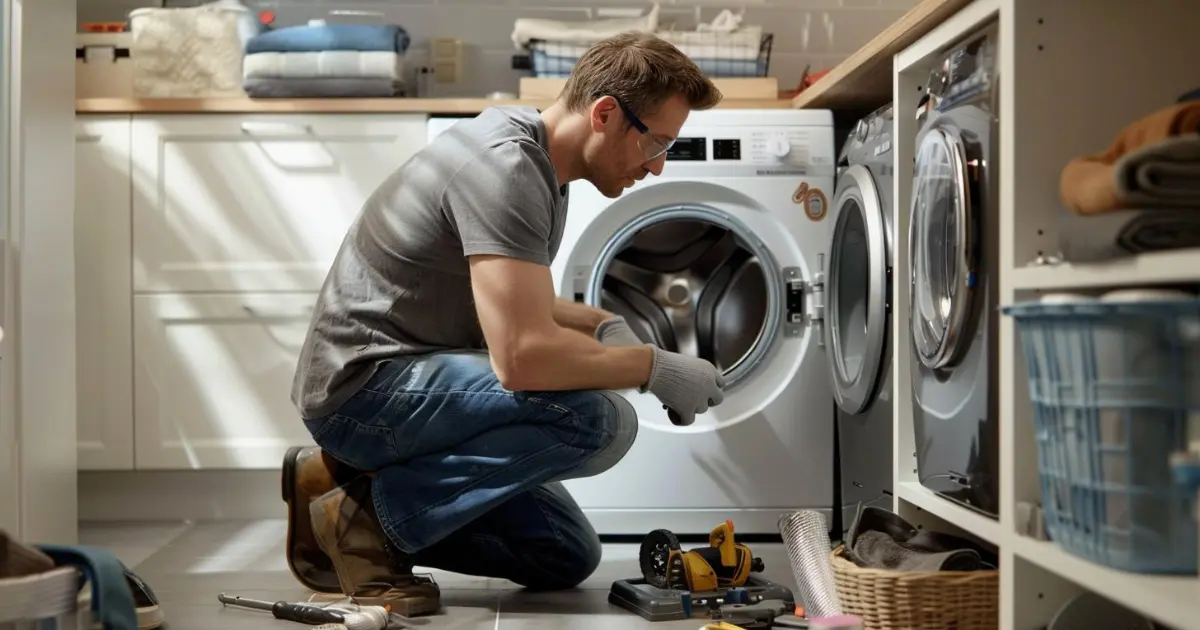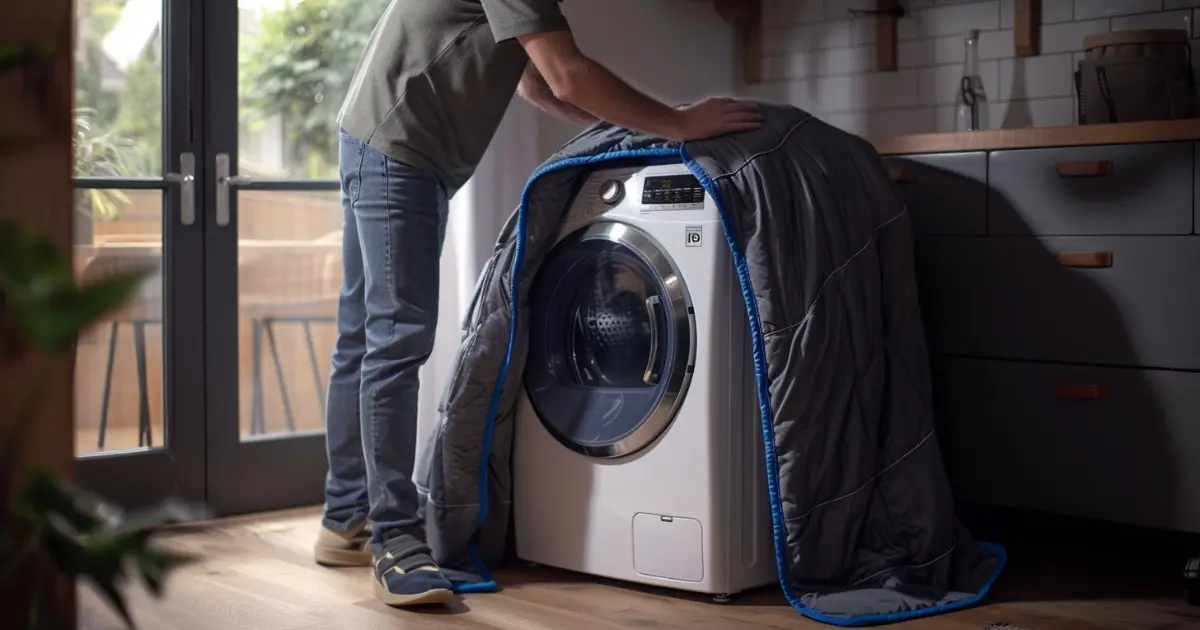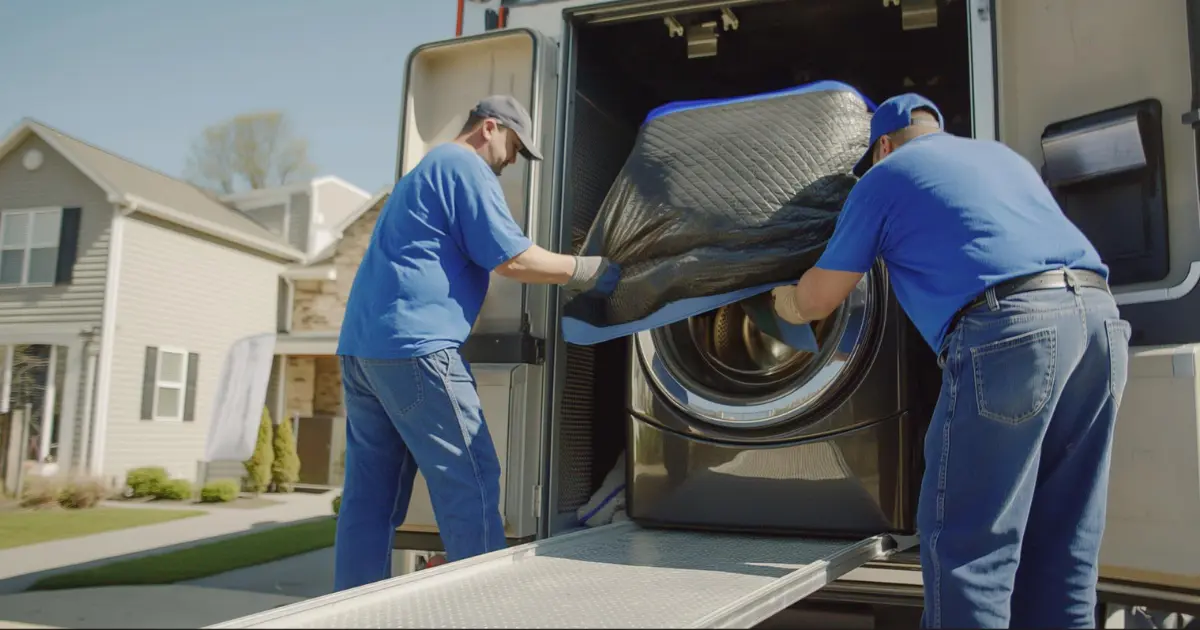Wondering how to move a washer and dryer to a new location? This guide has got you covered!
Washers and dryers are essential household appliances that significantly ease laundry chores. However, when it comes to relocating them to a new location, they are typically heavy. Their weight can range from approximately 150 to 200 pounds, depending on the brand and model you own.
Moving a washer and dryer can be time-consuming, especially without the right tools and supplies.
Whether you’re relocating, purchasing a new appliance, or remodeling your space, you need to know the best practices on how to move the washer and dryer quickly without any damage.
How to prepare a washer and dryer for the move?
Preparing for your move before the big day can make everything go more smoothly.
When moving big appliances like a washer and dryer, remember to be extra careful at every step.
If you’re unsure of anything, don’t hesitate to contact professional movers. Also, remember to check the user manual for instructions on how to prepare a washer for the move.
Check the lists below to ensure you have the right things, get the best help, and set up your space correctly for the moving job.
Safety first
- Lift the washing machine properly to avoid muscle strain and injuries.
- Wear gloves to safeguard your hands and ensure a secure grip on the machine.
- Use steel-toed footwear to protect your feet from injuries if the washer is dropped or slips off the appliance cart.
- At least one other adult should be available to help lift the washer onto an appliance cart and maintain balance during movement.
Tools and Supplies needed to move washer and dryer yourself
- Appliance dolly or hand truck
- Moving blankets
- Sliding pads
- Stretch tape
- Protective sheets
Here are 10 Tips to Easily Move Washer and Dryer by Yourself
Moving a washer and dryer requires careful planning, but with essential moving tips and the right steps, you can ensure they arrive at your new home without any problems.
1. Unplug and Disconnect your washer and dryer

This is the first step. Unplug the machines from the socket and make sure all hoses are disconnected. If you have gas dryers, shut off the gas main and open a window for ventilation.
Start a few days before you move the appliance, and wash all the essential clothes in advance that you don’t want to take with you. Remember to plan your move for all the things you can get to.
Pro Tip: Before moving day, measure the dimensions of your new laundry space. This helps you confirm that your washer and dryer will fit seamlessly, preventing surprises or adjustments upon arrival.
2. Turn Off the Water Supply

Shut off the washer’s water supply, both cold and hot water valves. This will prevent water flow to the washer during the move.
Once the water valves are closed, run a short cycle on the washer to remove any remaining water in the hoses. Doing this helps minimize spills when disconnecting the hoses. When done, neatly tape the drainage hose to the washer and wrap it to the sides with packing tape.
Pro tip: Label the cords and hoses with colored stickers or tape. This will make it easier to identify and reconnect them correctly at your new home. Make sure to understand the right labeling technique before you go ahead.
3. Clean your washer and dryer

Give your appliances a good clean by wiping them down with a damp cloth or mild soap to remove detergent residues. If you have time, leave the door open to allow the machine to dry out for at least 24 hours before moving it.
4. Secure the Drum (For Washers)

Check if your washer comes with a drum-securing kit. Contact the manufacturer or a local repair shop if your equipment does not have the original bolts.
For the front-loading washers, transit bolts help hold the drum and prevent it from damage. These bolts are specifically designed to avoid any movement or shifting that could lead to damage during transit.
Pro tip: Follow the manufacturer’s guidelines or seek professional advice on properly installing and removing transit bolts to safely secure the drum on a washing machine during the move.
5. Dismantle The Washer and Dryer (if necessary)

Depending on the model and brand of your machines, you can dismantle removable parts or accessories. This can significantly improve the ease and safety of moving your appliances, making them more manageable and reducing the risk of damage during the move.
Before you start the process, check the user manual for your washer and dryer to identify any specific guidelines provided by the manufacturer. Common removable parts may include lint traps, knobs, shelves, or any components that can be detached without compromising the functionality of the appliances.
For washers, consider disconnecting the agitator and securing it separately. If your dryer has a detachable lint trap or exhaust hose, these should be removed and packed individually. Be sure to label and keep all screws, bolts, and minor components in a marked bag or container to avoid any confusion during reassembly.
Pro tip: Take photographs of the dismantling process, especially if you’re unfamiliar with the machine’s inner workings. This will ease the process of reassembling the appliances at your new location.
6. Protecting the machines

Now is the time to wrap the machines before moving. If you are unfamiliar with packing services, take some time to learn the essential techniques before your big moving day.
You can use moving blankets, pads, or bubble wrap to secure the washer and dryer and move straps or rope around them to ensure complete safety from scratches or dents.
If you don’t have moving blankets, you can use furniture pads or even old blankets to work as alternatives.
Pro tip: In addition to using the blankets, try to add layers of bubble wrap around the more delicate and exposed parts of the machine, such as control panels, knobs, or glass doors. This extra coverage serves as a shock absorber and reduces the risk of damage caused by bumps or vibrations during transportation.
7. Use Dolly to move the washer and dryer
Place a dolly under each machine and secure it with straps. This smart move can make the entire process more efficient and less physically demanding.
However, you need to be extra careful to keep both machines upright to prevent operating damage. If this seems complicated, ask friends or get a professional moving service, especially if the move involves downstairs or upstairs.
8. Loading into the moving truck

Use proper lifting techniques to avoid strain or injury when lifting your appliances. Try to lift with your legs and not use your back.
Bend at the knees, keep your back straight, and maintain a firm grip on the appliances to distribute the weight evenly.
Once inside the truck, place the appliances in a secure area, and if necessary, use additional straps or tie-downs to prevent any potential movement during the move.
This will ensure that your washer and dryer remain stable and protected throughout the journey and minimize the risk of bumps or sudden stops.
9. Avoid overloading
Ensure the truck is not overloaded with appliances that provide enough space and stability for the washer and dryer.
Plan well if you have other items to move alongside the washer and dryer. Distribute the weight evenly throughout the truck to maintain balance, and place heavier items on top of the bottom and lighter items. Be careful of the weight distribution; if needed, use additional padding or security measures for added protection.
Finally, drive with caution to avoid sudden stops or sharp turns.
10. Unloading and setup
When unloading washers and dryers at your new home, be careful to prevent mishaps that could damage the appliances and your new home.
Here are some tips that you can follow:
- Gradually and carefully bring the truck to a stop, avoiding abrupt halts that could cause the washer and dryer to shift within the cargo area.
- Once inside your new home, place the washer and dryer in their designated locations.
- Avoid dragging the appliances across the floor to prevent scratches or damage.
- If you encounter any difficulties or uncertainties during the unloading process, don’t hesitate to seek assistance from friends, family, or professional movers.
How to move a stacked washer and dryer?
If you want to move a stacked washer and dryer, consider using ropes to secure both appliances and prevent any shifting during transportation. When lifting, ensure an upright position to avoid damage and pad the units with moving blankets for extra protection.
Rest assured, the above-discussed points for moving a stacked washer and dryer are applicable. This will ensure a smooth and secure relocation process. Before reinstallation, consult the manufacturer’s guidelines for proper stacking and setup in your new laundry space.
Should you leave the washer and dryer behind?
The decision to move or leave behind your large appliances depends on your needs. Leaving them behind can simplify your move and help save time and money.
On the other hand, if you’ve recently invested in new appliances or value-specific features, you should bring them along. Consider the following factors to make the right decision.
- Large appliances like washers and dryers always add to moving costs due to their weight and size.
- If you’re not emotionally attached to your appliances, leaving them behind will prove a cost-effective choice, especially for long-distance moves.
- If the appliance is not good enough to use, you can consider selling it. However, check the purchase contract to determine whether leaving appliances is a requirement or an option.
- Newer appliances usually withstand the move better than old appliances, as older ones are more susceptible to damage due to the stress of transportation.
- Double-check if your appliances fit the layout of your new home. If they don’t, it might be an opportunity to upgrade to units that better suit your space.
Ultimately, the decision depends on your priorities, the condition of your appliances, and the logistics of your move. Considering these factors will help you determine whether taking your large washer and dryer with you is the right choice for your situation.
Can you move the washer and dryer yourself?
If the thought of unplugging and transporting these bulky beasts seems daunting, it is wise to leave the task to professionals. Professional movers have the physical strength and expertise needed to move washers and dryers safely without damage.
However, if you’re confident in your physical strength and health, you won’t need to worry about hiring professional movers and paying them for the service. Take the time to disconnect the appliances, prepare them for the move, and rent or buy the right equipment to handle the washer and dryer’s weight.
If you are confused about whether to move your washer and dryer yourself or hire professional movers, consider the advantages and disadvantages.
Moving Yourself
| Pros | Cons |
| Cost savings | Physical strain and effort |
| Personal control over the process | Potential for damage without professional expertise |
Hire Professional movers
| Pros | Cons |
| Efficiency and quicker moving process | Less personal involvement in the move |
| Less risk of damage to appliances | Higher cost |
If you’re leaning towards getting a professional service, it is smart to assess the safety of choosing craigslist movers.
Remember to consider your preferences, available resources, and the complexity of the move to make the best decision for your situation.
While it is advisable to seek professional help when disconnecting and moving a washer and dryer, if you’re doing it yourself, you should possess practical know-how and have strong muscles.
Frequently Asked Questions on How to Move Washer and Dryer
Can I reinstall my washer and dryer on my own at the new location?
You can reinstall your washer and dryer on your own at the new location by following our step-by-step guide from YouTube or using the appliance manual.
Is it cost-effective to hire professional movers for my washer and dryer?
We recommend considering the costs and benefits of hiring professional movers versus doing it yourself before deciding on the most cost-effective option for moving your washer and dryer.
What precautions should I take to prevent damage during the move?
To minimize the risk of damage during the move, use padding, secure cords, and employ proper lifting techniques.
How can I make the process more eco-friendly?
Consider recycling old appliances and using eco-friendly packing materials to reduce the environmental impact of your move.
Are there any safety tips specific to moving laundry appliances?
Secure cords, drain water, measure doorways, and lift with proper techniques to ensure a smooth and injury-free move. If needed, get assistance from professionals.
What should I do to store my washer and dryer during the move?
Clean and dry the appliances thoroughly, disconnect utilities, and wrap them securely to prevent damage while in storage.



